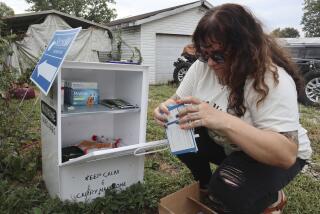Op-Ed: To curb fatal drug overdoses, the U.S. urgently needs safe injection sites. The problem is they’re illegal
In the 1990s, Vancouver, Canada, experienced an overdose crisis similar to the epidemic sweeping the United States. The surge was driven by a potent supply of China White heroin. The city saw more than 1,300 fatal overdoses over the course of the decade. During the worst year of the crisis, 1998, there were some 400 fatal overdoses across British Columbia.
This rate of fatal overdoses was considered so unfathomable that Vancouver was galvanized into action. Activists marched in the streets and occupied City Hall, demanding that drug users have a say in drug policy. Advocates pushed for “harm reduction,” a set of strategies in which the goal is not to eliminate drug use, but rather to minimize its worst outcomes.
As a result, Vancouver adopted a host of progressive programs, such as needle exchanges, and in 2003 opened North America’s first sanctioned supervised injection facility, Insite. There, people can use illegal drugs under the supervision of nurses without fear of apprehension by police.
In the following decade, British Colombia saw a roughly 50% reduction in annual overdose deaths. Other Canadian cities followed Vancouver’s lead. There are now more than 25 supervised injection facilities across Canada.
While it’s critical that unsanctioned sites exist, it is also absurd.
When you compare the low points of Vancouver’s previous epidemic — 1,300 dead in the city over a decade, 400 across British Columbia at its peak — to overdose rates in the United States right now, it’s shocking that more Americans aren’t marching in the streets. There were 1,217 fatal overdoses in Philadelphia in 2017 alone, and some 70,000 fatal overdoses across the country.
The United States needs supervised injection facilities more than ever. But it is illegal to establish them because of the so-called crack house statute, a federal law that forbids the operation of spaces for the purposes of making, distributing or using controlled substances. Instead, drug users in the United States must rely on makeshift versions. In many cities, these spaces function similarly to Canada’s sanctioned facilities. Just don’t call them supervised injection sites.
I recently traveled to a number of these places across the Northeast to learn how drug users and their allies are responding to fentanyl. The dangerous synthetic opioid was linked to about 40% of last year’s fatal overdoses in the United States, up from roughly 31% the previous year. (Fentanyl is behind a new epidemic in Canada as well, causing 84% of some 1,450 fatal overdoses across British Columbia last year.)
In New York, I visited Washington Heights Corner Project in the Bronx. You can’t inject drugs out in the open there, so people inject drugs in the bathrooms, behind closed doors. The staff cannot stop clients from using their bathrooms, though they know some clients will do drugs in them. So they make the situation as safe as possible, within the confines of federal law, providing clean needles and other supplies. If a client has been in a bathroom for too long and does not respond to a knock on the door, the staff will enter and, if necessary, respond to an overdose if that’s what has occurred.
In Boston, I visited the Boston Health Care for the Homeless Program, a one-stop-shop for those in need located on “Methadone Mile.” Their bathroom situation is similar to Corner Project’s, but they’ve added another service: the Supportive Place for Observation and Treatment. It’s a simple room off the lobby where someone who feels they are at risk of an overdose can rest under the supervision of a nurse. In other words, users can obtain a clean needle and use drugs in a bathroom, then walk across the lobby to this room.
I also visited a number of so-called crack dens and shooting galleries in Philadelphia’s Kensington neighborhood. At these informal gatherings, hidden along train tracks and in the forest, drug users take a strength-in-numbers approach by supervising one another. Outreach workers often circulate, handing out syringes, cookers and vials of clean water — safer alternatives to used needles, dirty spoons and puddle water.
Enter the Fray: First takes on the news of the minute from L.A. Times Opinion »
While it’s critical that these unsanctioned sites exist, it is also absurd. It’s absurd that Corner Project needs to provide a toilet and plumbing to clients who really only want to inject drugs. It’s absurd that visitors to Boston Health Care for the Homeless must inject drugs behind closed doors on one side of the building and then, if they feel they are at risk of overdosing, stumble across the lobby to a different room. And it’s absurd that users in Philadelphia are providing each other with almost every service that a supervised injection site would, but must do so in filthy conditions, hiding in dark alleys and along train tracks.
These shortcomings are not the result of drug use. They are the result of America’s failed war on drugs. With its annual death toll poised to surpass 70,000, the United States urgently needs to treat addiction as the healthcare issue it is.
Several American cities are reportedly considering safe injection sites, but they still face legal hurdles. The United States simply does not have another decade to waste before legalizing these facilities. By then, the death toll will be in the hundreds of thousands.
Travis Lupick is a journalist in Vancouver and the author of “Fighting for Space: How a Group of Drug Users Transformed One City’s Struggle with Addiction.” Follow him on Twitter: @tlupick.
Follow the Opinion section on Twitter @latimesopinion or Facebook.
More to Read
A cure for the common opinion
Get thought-provoking perspectives with our weekly newsletter.
You may occasionally receive promotional content from the Los Angeles Times.










